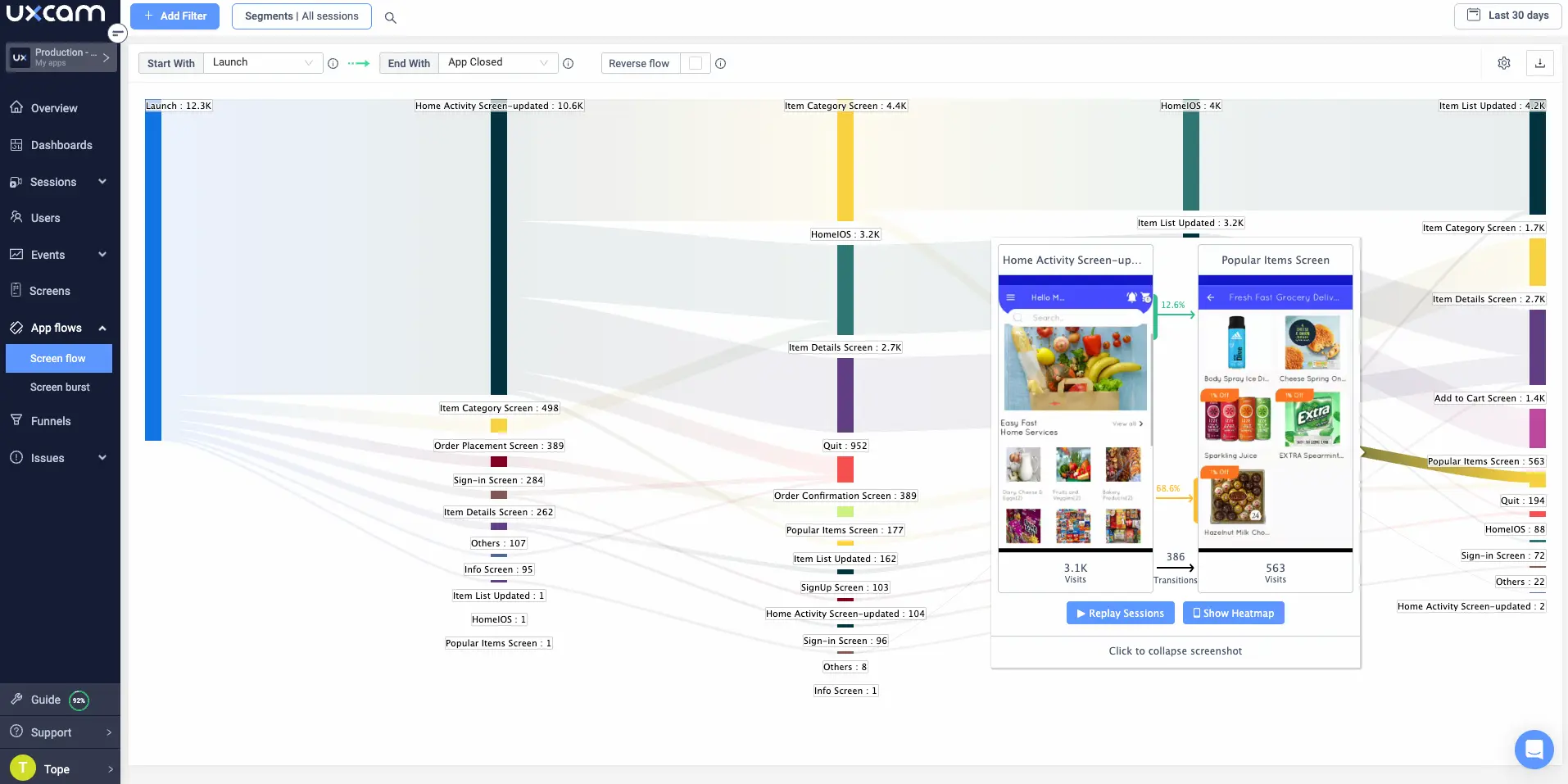Back to blog
5 MIN READ
How to Build a GDPR-Compliant Mobile App - Step-by-Step Guide
PUBLISHED
16 April, 2024

Product Analytics Expert
Designing a GDPR-compliant mobile app isn't only important for compliance, but also for building trust with customers. According to a study conducted by AdPushUp, 80% of respondents stated that they would be more inclined to purchase from companies they perceive as protecting their personal data.
Incorporating user-friendly consent mechanisms into your mobile app can not only ensure GDPR compliance but also enhance the trustworthiness of your brand. At UXCam, we understand the importance of designing interfaces that effectively communicate GDPR consent to users.
So, in this guide, we aim to provide clear, step-by-step instructions for building a GDPR-compliant mobile app.
Helpful summary
Overview: The guide explains how to build a GDPR-compliant mobile app, emphasizing the importance of user trust and legal compliance.
Why listen to us: UXCam has helped the best mobile app product teams worldwide improve their app user experiences while complying with GDPR.
Why it matters: GDPR compliance is important for avoiding legal penalties and maintaining user trust.
Action points: Minimize data collection, implement user consent mechanisms, ensure data security, provide user control over their data, and regularly update privacy policies.
Further research: Developers should continue exploring GDPR requirements and stay updated on privacy regulations
Why listen to us?
GDPR compliance for mobile apps is important.
At UXCam, we prioritize privacy and data protection with our GDPR-compliant tracking solutions. Our tool enhances app usability and performance while responsibly handling user data. By aligning with global privacy regulations, we demonstrate our commitment to legal compliance and ethical standards in app development.
What is a GDPR-compliant mobile app?
GDPR (or General Data Protection Regulation for long) is an EU data regulation that imposes strict rules on how businesses handle the personal data of EU citizens. A GDPR-compliant mobile app is an app that adheres to these rules.
The full legal requirements are too long to cover in full, but here are the core principles:
Consent: Users need to give informed consent before their personal data can be collected and processed.
Data minimization: Only the minimum amount of personal data necessary should be collected and processed for a specific purpose.
Limitation of purpose: Data collected can only be used for the specific purpose it was collected for.
Transparency: Users need to be informed about the data you’re collecting.
Data Portability: Users have to be able to easily transfer their data to another service if they wish.
Right to be forgotten: Users have the right to request that their personal data be deleted.
Data security: Personal data has to be kept secure and protected.
Why is it important to build a GDPR-compliant app?
It may be a regulatory requirement
If your app is available to users that live in the EU, it needs to be GDPR-compliant. Even if EU citizens make up just 0.01% of your user base, you still have to make sure that your app follows GDPR guidelines. That’s one of the reasons why many apps are geo-locked to non-EU regions.
The costs of non-compliance could be up to €20 million or 4% of your company’s annual revenue, whichever is higher. It’s not something that you want to risk, especially for small businesses or startups.
It helps protect privacy
GDPR is widely recognized as a uniquely comprehensive data privacy regulation. Its requirements surrounding the right to be forgotten, data portability, and explicit consent have become global standards for protecting user privacy.
The point is, if you believe that data privacy is an important issue, then GDPR compliance should be a top priority for your app.
It helps improve your data management
Finally, building a GDPR-compliant app forces you to think critically about how you collect, store, and analyze data. The result of this exercise is often that you end up with a more efficient and streamlined data management process.
How to build a GDPR-compliant mobile app
Understand GDPR requirements
Determine what data you need to collect
Build in GDPR-compliant feature
Ensure data security and integrity
Set up GDPR-compliant tracking
Step 1: Understand GDPR requirements
Before diving into the development process, it's essential to have a solid understanding of the GDPR requirements. This regulation imposes strict rules on the collection, storage, and processing of personal data, emphasizing transparency, user consent, and the right to be forgotten.
Step 2: Determine what data you need to collect
One of the fundamental principles of GDPR is data minimization. Basically, you should only be collecting data that’s necessary for your app’s functionality. So, a natural first step is working out what that data is.
Most apps will need to collect names and email addresses at a minimum. That said, there are all kinds of scenarios that demand additional data. To help you out, here’s a list of Personally Identifiable Information (PII) you might have to collect:
Direct Identifiers:
Name
Social Security Number (SSN)
Passport number
Driver’s license number
Taxpayer identification number (TIN)
Email address
Telephone number
Biometric records (e.g., fingerprints)
Indirect Identifiers:
Date and place of birth
Mother’s maiden name
Race
Gender
Geographic location
Financial information
Medical history
Employment history
Educational information
Any data you intend to collect needs to be disclosed in an easily accessible privacy policy that users consent to before you collect any data. This policy should explain the purpose of collecting their data, how it will be used and protected, and who it will be shared with (e.g., analytics providers like UXCam).
Step 3: Build in GDPR-compliant feature
When you’re building a GDPR-compliant app, it’s always a good idea to build in privacy features from the start.
What features do we mean? There are a few that are essentially required:
Data download or export buttons: Somewhere in your app (or on your landing page) there needs to be a feature that users can use to easily download or export their data. This could be a button, a form, or even just a link.
Data deletion options: Users also have the right to request that their data be deleted. This means your app should have a feature for them to easily delete all of their data from your system. In some instances, you’ll need to program in a window of time for the data to be fully deleted.
Privacy policy opt-in: As mentioned earlier, we need to build out a simple (but comprehensive) privacy policy that users can agree to when signing up for your app. The opt-in screen should be quick, but give users the option to view policies in full.
Step 4: Ensure data security and integrity
Protecting user data is a top priority under GDPR. Implement robust security measures to safeguard personal information, both during transmission and storage. Regularly update your app's security protocols to address emerging threats.
Step 5: Set up GDPR-compliant tracking
Every great mobile app relies on user data analysis to improve, but this process also needs to be GDPR-compliant. That means choosing an analytics platform that offers GDPR-compliant tracking and analytics is a must.

UXCam is a great example of an analytics platform that prioritizes data privacy and security without sacrificing features. We offer mobile product teams a suite of tools designed to uncover the “whys” behind user behavior, including:
Session replays
Heatmaps
Funnels
User journey maps
Issue analytics
To support GDPR-compliance, we offer a range of privacy-focused features for both developers and users, including:
The option to delete user data
The option to discard IP address
The option to provide the customer with a copy of their data
The option for users to opt-in and opt-out of tracking
You can also use our client-side Hide Sensitive Data API to block sensitive information before it ever reaches our servers. This allows you to maintain data privacy while still gaining valuable insights into user behavior.
Thanks to these features and UXCam’s strict data security policies, it’s simple to maintain GDPR-compliance while tracking user behavior with our platform. All you need to do is include UXCam in your privacy policy and digitally sign our DPA.
Conclusion
Building a GDPR-compliant mobile app is important for maintaining user trust and avoiding legal consequences. By following our step-by-step guide and leveraging the capabilities of UXCam, mobile app developers can streamline the process of achieving GDPR compliance.
UXCam's comprehensive features, including tagless autocapture, market-leading SDK, powerful integrations, and user-centric analytics, make it an invaluable tool for understanding user behavior, improving UX, and building privacy-conscious applications.
Sign up for free to get started.
You might also be interested in these;
How to analyze session recordings
AUTHOR

Tope Longe
Product Analytics Expert
Ardent technophile exploring the world of mobile app product management at UXCam.
What’s UXCam?
Related articles
Mobile app analytics
5 Best Session Replay Tools to Identify Mobile App UX Issues
We’ve highlighted the top picks on the market for session replay tools and dug into what they’re known for, who they’re best for, and what users say about...

Audrey Meissner
Mobile app analytics
How to improve mobile app performance
Discover the secrets to improving your mobile app's performance. From monitoring crashes and UI freezes to minimizing app launch delay; improve your user's experience...

Tope Longe
Product Analytics Expert
Mobile app analytics
Amplitude Mobile Analytics - Get the WHY with UXCam
Explore the key features and limitations of Amplitude mobile analytics and discover how integrating it with UXCam can provide a more comprehensive...

Tope Longe
Product Analytics Expert
